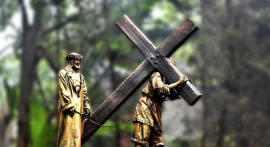Transitioning from being the youth pastor of a smaller-sized church with 14 students, to being the youth pastor of a group that’s 10 times larger, comes with some unique challenges as well as new opportunities and lessons, says Pastor Arnold Kim.
Kim, who used to serve at Las Vegas Presbyterian Church, recently moved to California and currently serves as the youth pastor at Cerritos Presbyterian Church.
First, there was the emotional challenge of having to leave behind a group that Kim has invested in and built relationships with for three years.
“It was like family,” Kim recalled, who tears up even now as he’s asked about the youth group in Las Vegas.
“I was conflicted because I thought, ‘How will they survive without me?’ ‘What will happen to this church after I leave?’” Kim shared.
But talking to his colleagues humbled and comforted him, he recalled, especially as one asked, “Do you really think that God will not take care of his own people?”

Arnold Kim currently serves as the youth pastor at Cerritos Presbyterian Church.
The challenge of adjusting to the vast amount of administrative differences of leading a group of 14 versus 140 was another that Kim had to learn through and overcome.
For example, with the group of 14 at Las Vegas Presbyterian Church, much of the fellowship and events were done spontaneously, Kim explained. A youth kid once asked Kim several days before the weekend, “Can we have a lock-in this Friday night?”
“Sure, I don’t see why not?” Kim recalled saying in response. It was as easy as that to organize events and to build more intimate relationships with the students.
With a group of 140 kids, this type of spontaneity is almost impossible. All of the events must be organized and planned in advance, and all of the volunteers and teachers must move together, Kim explained. Small tasks such as getting snacks for an event which used to be not so difficult with 14 students suddenly became a major challenge when faced with having to provide food for 140.
Relating to each and every student in the youth group and building relationships with them is also much more difficult, said Kim, and while before, he was able to teach the students about God and the Bible one-on-one, he now must delegate the teaching to several teachers for the bigger youth group.
The teaching influence that he now has on each student is no longer singular, but rather, divided to several people, Kim said. As he preaches on Sundays, he also trains youth group teachers, who then also help guide youth group students in small groups.
“It’s now a 50:50 ratio between the teachers and the students in terms of giving my effort and attention,” Kim said. “Every Sunday, I meet up with the youth group teachers and go over next week’s Bible study in advance.”
And while with the smaller group, Kim was able to connect with each student personally, he now relies on the youth teachers’ feedback and updates to understand how the larger group is doing.
A benefit to having a larger group of students and serving at a larger church, however, is that there are many more hands to go around when in need of help during an event or missions trip. The group can receive more resources and even hire their own worship pastor for the event or trip.
But there are some things that don’t change whether the group is small or large, Kim said, including his heart and vision for youth. Whether he is able to interact with each member of the youth group individually, or have more interaction with volunteers and teachers, Kim’s main objective when serving is to emphasize the ‘what’ of the gospel and ‘why’ a person believes in Jesus Christ.
“Knowing who Jesus is and why they are able to trust in Jesus is important, especially in today’s society,” Kim explained.
“Ministering in these different contexts and seeing how God can use me to glorify His kingdom — that’s always a blessed thing,” Kim said.












